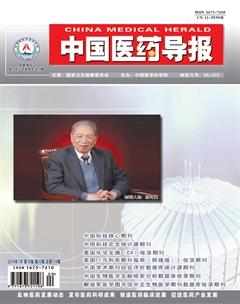2型糖尿病患者发生颈动脉斑块的影响因素分析
张蕊 赵晓冉 郭宏英 房亮 刘晓燕



[摘要] 目的 探讨2型糖尿病患者颈动脉斑块的危险因素。 方法 选取2016年1月~2018年1月于承德医学院附属医院就诊住院的2型糖尿病患者192例为研究对象,根据内膜中层厚度(IMT)将其分为斑块组(n = 101)和无斑块组(n = 91);收集患者临床资料及实验室指标;比较两组临床资料及实验室指标;采用二元多因素Logistic分析对颈动脉斑块的危险因素进行分析。 结果 斑块组年龄、腰围、糖尿病病程、有吸烟史患者数、糖化血红蛋白(HbA1c)、三酰甘油(TG)、低密度脂蛋白胆固醇(LDL-C)水平显著高于无斑块组(P < 0.05),而25羟维生素D3 [25(OH)D3]水平、服用他汀类患者数显著低于无斑块组,差异有统计学意义(P < 0.05)。多因素Logistic分析结果显示,糖尿病病程(OR:1.06,95%CI:1.03~1.08,P = 0.021)、吸烟(OR:1.13,95%CI:1.10~1.16,P = 0.005)、HbA1c(OR:1.46,95%CI:1.24~1.54,P = 0.010)及LDL-C(OR:1.28,95%CI:1.16~1.42,P = 0.014)為颈动脉斑块发生的危险因素,而25(OH)D3(OR:0.84,95%CI:0.82~0.87,P = 0.000)、服用他汀类(OR:0.78,95%CI:0.72~0.82,P = 0.039)则为其保护因素。 结论 随着病程的延长,2型糖尿病患者颈动脉斑块发生风险上升,吸烟、HbA1c及LDL-C水平升高均使颈动脉斑块发生风险增加,而高25(OH)D3水平、服用他汀类则可能延缓其发生发展。
[关键词] 25-羟维生素D3;2型糖尿病;内膜中层厚度;颈动脉斑块
[中图分类号] R587.1;R543.4 [文献标识码] A [文章编号] 1673-7210(2019)07(b)-0072-04
Analysis of influencing factors of carotid plaque in patients with type 2 diabetes mellitus
ZHANG Rui1 ZHAO Xiaoran1 GUO Hongying2 FANG Liang1 LIU Xiaoyan1
1.Department of Endocrine, Affiliated Hospital of Chengde Medical University, Hebei Province, Chengde 067000, China; 2.Department of Medical, Tianjin Medical University General Hospital Airport Hospital, Tianjin 300308, China
[Abstract] Objective To investigate the risk factors of carotid plaque in patients with type 2 diabetes mellitus. Methods A total of 192 patients with type 2 diabetes mellitus who were admitted and hospitalized in Affiliated Hospital of Chengde Medical University from January 2016 to January 2018 were selected for the study. They were divided into plaque group (n = 101) and non-plaque group (n = 91) according to intima-media thickness (IMT). Clinical data and laboratory indicators were collected and compared between the two groups. Risk factors of carotid plaque were analyzed by binary multivariate Logistic analysis. Results The age, waist circumference, duration of diabetes mellitus, number of smokers, glycosylated hemoglobin (HbA1c), triglyceride (TG), low density lipoprotein cholesterol (LDL-C) levels in plaque group were significantly higher than those in non-plaque group (P < 0.05), while 25-hydroxyvitamin D3 [25 (OH) D3] levels and the number of patients taking statins were significantly lower than those in non-plaque group (P < 0.05), the differences were statistically significant (P < 0.05). Multivariate Logistic analysis showed that the duration of diabetes mellitus (OR: 1.06, 95%CI: 1.03-1.08, P = 0.021), smoking (OR: 1.13, 95%CI: 1.10-1.16, P = 0.005), HbA1c (OR: 1.46, 95%CI: 1.24-1.54, P = 0.010) and LDL-C (OR: 1.28, 95%CI: 1.16-1.42, P = 0.014) were the risk factors for carotid artery plaque, and elevated level of 25(OH)D3(OR: 0.84,95%CI: 0.82-0.87, P = 0.000) and taking statins(OR: 0.78,95%CI: 0.72-0.82, P = 0.039)were the protective factors. Conclusion With the prolongation of the course of disease, the risk of carotid plaque in type 2 diabetes mellitus increased. Smoking, elevated levels of HBA1c and LDL-C all can increase the risk of carotid plaque, while high level of 25 (OH) D3 and taking statins may delay the development of carotid plaque.

